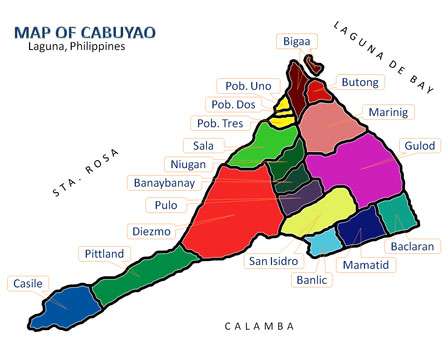Banay-Banay, Cabuyao
Barangay Banay-Banay (PSGC: 043404002) is one of the eighteen (18) urbanized[1] barangays comprising the progressive City of Cabuyao in the province of Laguna, Philippines. It lies for about 2.5 kilometers away from the city proper of Cabuyao and is situated at the central portion of the city. According to the 2010 Census,[2] it has a population of 21,934 inhabitants (grew from 17,419 in Census 2007[3]), making it ranked as 4th largest barangay in Cabuyao when it comes to population.
Barangay Banay-Banay City of Cabuyao | |
|---|---|
 Pamantasan ng Cabuyao | |
| Nickname(s): Nayon ng Banay-Banay, Barrio Banay-Banay | |
| Country | |
| Region | Calabarzon (Region IV-A) |
| Province | Laguna |
| City | Cabuyao |
| Incorporated (settlement) | 1571 |
| Government | |
| • Type | Sangguniang Barangay, with Chairman as its head supported by seven (7) Barangay Councilors |
| • Barangay Chairman | Efren B. Cabuang |
| Area | |
| • Urbanized Barangay | 3.10 km2 (1.20 sq mi) |
| Population (May 2010) | |
| • Urbanized Barangay | 21,934 |
| • Density | 7,100/km2 (18,000/sq mi) |
| • Urban | 21,934 |
| Time zone | UTC+8 (PST) |
| • Summer (DST) | Manila |
| Zip Code | 4025 |
| Area code(s) | 049 |
| Languages | Tagalog and English |
| Demonym | Banay-Banense, Banay-Baneños |
Barangay Banay-Banay is popular for being the site of the town's very own university, the Pamantasan ng Cabuyao, where a big number of students are studying there.
Geography
Land Area
The total land area of Barangay Banay-Banay is 310.12 hectares (has.) or 3.1012 square kilometers (km2), ranking sixth (6th) out of eighteen (18) barangays in the city of Cabuyao when it comes to land area. It lies for about 2.5 kilometers (km) away from the city proper and is situated along the National Highway.[4]
Location
It is located north of Brgy. Pulo, east of Brgy. Diezmo, south of Brgy. Niugan and west of Brgy. Gulod in Cabuyao, Laguna.
It is also one of the six (6) barangays of the town along the National Highway while the others are Barangays Banlic, Niugan, Pulo, Sala and San Isidro.[4]
Climate
Types of Seasons
The rainfall regime of Barangay Banay-Banay is characterized by the two (2) pronounced seasons, the wet and dry seasons. The wet season which is from June to November and the relatively dry season that lasts from December to May. The average rainfall is about 2,000 mm of rain falling in an average year, there are about 150 days which are rainy days.[5]
Temperature
The seasonal variations of the Temperature field is uneventful. The coldest months start from November up to January and the warmest month on the record is the month of May. On the average, a 12 °C temperature difference exists between the warmest and coolest months. The mean annual temperature is a warm 27.5 °C.[5]
Humidity
The annual relative Humidity is 70%. The most humid months are June, July, August and September with the normal relative humidity registered at 84%, while April and May are the driest at 70%.[5]
Demography
According to 2010 Census,[2] it has a population of 21,934 inhabitants, grew from 17,419 in Census 2007.[3]
| No. | Barangay | Rank | Population (2007) | Population (2010) | Population Density (2010) | Annual Growth Rate (Average) |
|---|---|---|---|---|---|---|
| 1 | Baclaran | 9th | 12,683 | 12,192 | 6,985/km2 | |
| 2 | Banay-Banay | 4th | 17,419 | 21,934 | 7.073/km2 | |
| 3 | Banlic | 7th | 9,707 | 12,675 | 5,511/km2 | |
| 4 | Bigaa | 10th | 8,649 | 10,051 | 4,807/km2 | |
| 5 | Butong | 8th | 12,274 | 12,360 | 7,630/km2 | |
| 6 | Casile | 16th | 1,555 | 2,128 | 669/km2 | |
| 7 | Diezmo | 15th | 2,689 | 2,681 | 1,686/km2 | |
| 8 | Gulod | 11th | 10,127 | 9,417 | 2,304/km2 | |
| 9 | Mamatid | 1st | 37,166 | 50,213 | 19,313/km2 | |
| 10 | Marinig | 2nd | 25,619 | 37,169 | 9,494/km2 | |
| 11 | Niugan | 3rd | 21,993 | 26,807 | 7,615/km2 | |
| 12 | Pittland | 18th | 1,627 | 1,740 | 598/km2 | |
| 13 | Pulo | 6th | 13,193 | 15,124 | 5,041/km2 | |
| 14 | Sala | 12th | 7,491 | 8,275 | 5,353/km2 | |
| 15 | San Isidro | 5th | 15,495 | 18,145 | 5,767/km2 | |
| 16 | Barangay I Poblacion | 14th | 2,589 | 2,839 | 12,334/km2 | |
| 17 | Barangay II Poblacion | 17th | 1,947 | 1,840 | 7,886/km2 | |
| 18 | Barangay III Poblacion | 13th | 3,153 | 2,846 | 12,034/km2 | |
| TOTAL | 6th | 205,376 | 248,436 | 5,700/km2 |
Barangay Officials (2013-2016)
Barangay Captain: Eric E. Barron Sangguniang Barangay Members
- Christopher C. de Leon
- Cenon C. Marcha
- Rafael N. Pampang
- Anwar U. Aidarus
- Danica E. Gabriel
- Noel B. Caparas
See also
- Cabuyao, Laguna
- Laguna, Philippines
- Pamantasan ng Cabuyao
References
- Philippine Standard Geographic Code
- "Final Results - 2010 Census of Population". census.gov.ph. Archived from the original on 2012-07-07. Retrieved 2012-06-16.
- 2007 Census table for Laguna - National Statistics Office
- Cabuyao, Laguna/Barangay Location Archived 2012-01-28 at the Wayback Machine
- Cabuyao, Laguna/Physical Characteristics Archived 2010-10-29 at the Wayback Machine
